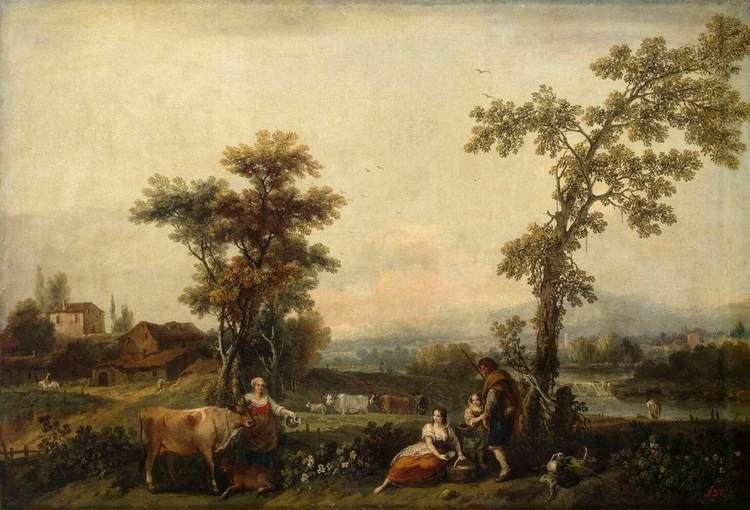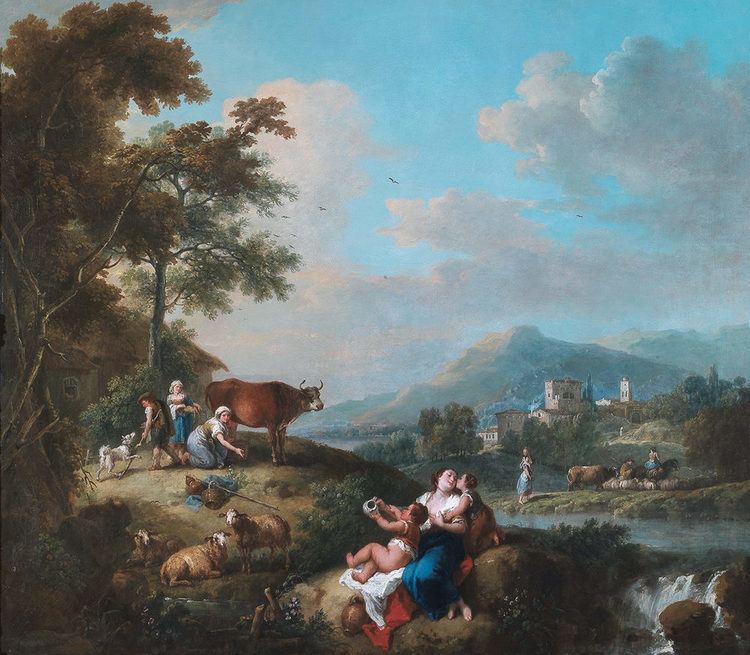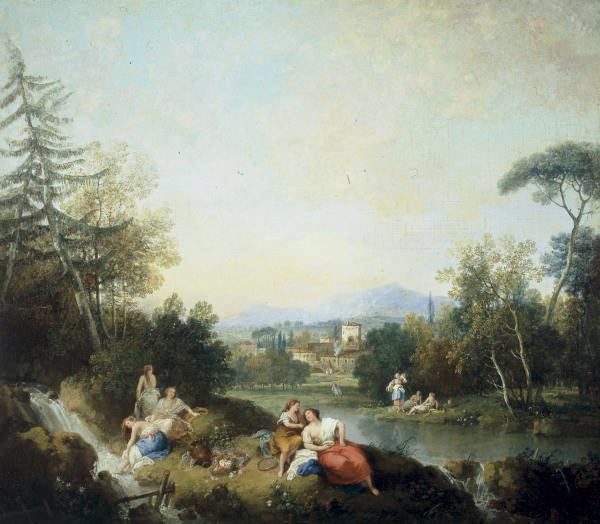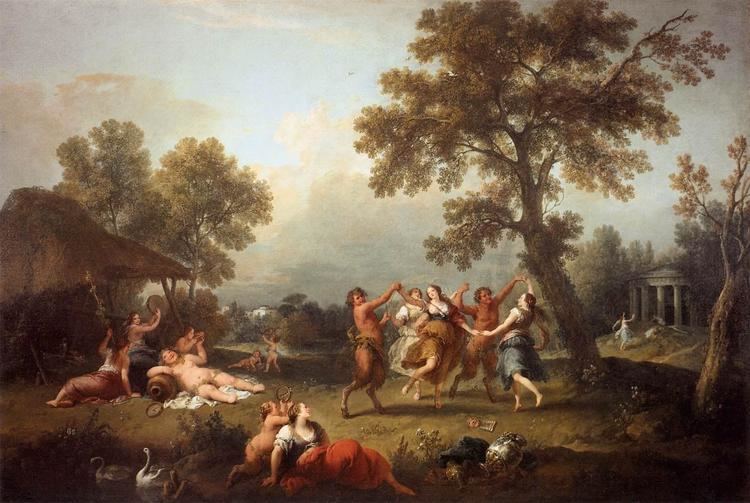Nationality Italian Name Francesco Zuccarelli Known for Painting | Movement Late Baroque or Rococo Period Rococo | |
 | ||
Born 15 August 1702 ( 1702-08-15 ) Pitigliano Died December 30, 1788, Florence, Italy Similar People Richard Wilson, Francesco Bartolozzi, Joshua Reynolds, Thomas Gainsborough, Angelica Kauffman | ||
Francesco Zuccarelli R.A. (1702-1788): An extensive Landscape with Figures Dancing
Francesco Zuccarelli RA ([franˈtʃesko dzukkaˈrelli], 15 August 1702 – 30 December 1788) was an Italian painter of the late Baroque or Rococo period. He is best known for his Arcadian landscapes that received initial renown in Venice and later achieved popularity in England where he resided for two extended periods. In 1768, he became a founding member of the Royal Academy of Arts, and upon his final return to Italy, he was elected president of the Venetian Academy.
Contents
- Francesco Zuccarelli RA 1702 1788 An extensive Landscape with Figures Dancing
- Rome and Tuscany 170232
- Venice and two stays in England 173271
- Final years in Italy 177188
- Reputation and legacy
- Identification of works
- References
Rome and Tuscany (1702–32)

Born at Pitigliano, in southern Tuscany, Zuccarelli began his apprenticeship in Rome c. 1713–14 with the portrait painters Giovanni Maria Morandi (1622–1717) and his pupil Pietro Nelli (1672–1740), under whose tutelage he learned the elements of design while absorbing the lessons of Roman classicism. Francesco completed his first commission in Pitigliano in the years 1724–27, a pair of chapel altarpieces. With the sponsorship of the Florentine art connoisseur, Francisco Maria Niccolo Gabburri (1676–1742), in the late 1720s and early 1730s Zuccarelli focused on etching. He eventually produced at least 43 prints, the majority consisting of two series which recorded the deteriorating frescoes of Giovanni da San Giovanni (1592–1636) and Andrea del Sarto (1486–1531). During his Tuscan period, though preoccuppied with figurative subjects, he began to experiment with drawings in landscape, and according to non-contemporary sources his introduction to the latter genre was through the Roman landscape painter and etcher Paolo Anesi (1697–1773).
Venice and two stays in England (1732–71)

In 1732, after a stay of several months in Bologna, Zuccarelli relocated to Venice. While continuing to paint religious and mythological works, he increasingly devoted his output to landscapes, his style at first taking after that of Alessandro Magnasco, and more lastingly, of Marco Ricci. Prior to his arrival in the Republic, the death of Marco Ricci in 1730 had created an opening in the field of landscape painting amid a marketplace crowded with history painters, and Zuccarelli's unique blend of countryside and Arcadia quickly attained success. Francesco brought a more mellow and airy palette to the typically Venetian colors, and his rural scenes were populated with small figures reminiscent of Claude, whose work he had studied in Rome. He also occasionally created pastiches of various 17th-century Dutch masters. Zuccarelli enjoyed early patronage in Venice, from amongst others, Marshal Schulenburg, Consul Smith, and Francesco Algarotti, who recommended him to the Elector of Saxony, Augustus III of Poland. He often collaborated with other artists, including Bernardo Bellotto and Antonio Visentini. In the mid-1740s, under the auspices of Consul Smith, he produced with Visentini a series featuring neo-Palladian architecture, as can be seen in Burlington House (1746). Most charming of the Zuccarelli and Visentini collaborations is a set of 52 playing cards with Old Testament subjects published in Venice in 1748. The hand-colored scenes are treated in a light manner, the suit symbols are ingenious, and the cards begin with the Creation of Adam and end with a battle scene that has an elephant carrying a castle. The outstanding achievement of his Venetian years was a series of seven canvases, traditionally ascribed to the Genesis story of Jacob, and now located at Windsor Castle. The tall paintings are couched in a tender and dream-like poetic vein, and were most likely originally situated at Consul Smith's villa at Mogliano. Towards 1750, when Zuccarelli reached his peak, his paint handling was very responsive to mood, bright with regard to color, thinly laid on and yet vibrantly effective.

Francesco travelled to England to 1752, where his decorative talent resulted in diverse work, including the design of tapestries with the weaver Paul Saunders at Holkham Hall. Around 1760 he turned to Shakespeare, depicting a scene from Macbeth where Macbeth and Banquo encounter the witches, noteworthy as being one of the first paintings to portray theatrical characters in a landscape. Zuccarelli held a sale of his canvases in 1762 at Prestage and Hobbs in London before his departure for Italy. In the same year, King George III acquired twenty-five of his works through the purchase of much of Consul Smith's extensive art collection and library in Venice. In 1763 he became a member of the Venetian Academy, but Zuccarelli was soon induced to journey back to London in 1765 by his friend Algarotti's bequest of a cameo and group of drawings made to Lord Chatham. On this second visit to England, he was lauded by the English nobility and critics alike, and invited to exhibit at leading art societies; moreover, King George III is said to have commissioned the out-sized painting River Landscape with the Finding of Moses (1768). Francesco Zuccarelli was a founding member, in 1768, of the Royal Academy of Arts.
Final years in Italy (1771–88)

Upon his return to Italy in 1771, Zuccarelli was soon afterward elected President of the Venetian Academy. The work of his late maturity can broadly be characterized as "neo-Riccian", for in this period the artist's style recalls the precision of his youthful emulation of Marco Ricci. Francesco Zuccarelli eventually settled in Florence, and he died there in 1788.
Reputation and legacy
Francesco Zuccarelli was one of the few Venetian painters of his era to win universal acclaim, even from critics who rejected the concept of Arcadia. He was especially popular among the followers of Rousseau. Francesco Maria Tassi (1716–1782), in his Lives of the Painters, Sculptors, and Architects of Bergamo remarks that Zuccarelli paints "landscapes with the most charming figures and thus excels not only artists of modern times but rivals the great geniuses of the past; for no one previously knew how to combine the delights of an harmonious ground with figures gracefully posed and represented in the most natural colours". With the move to more representational modes of depicting landscape in the 19th century, a reaction set in, and his works were to be the subject of the most disparaging invective. A reappraisal of the artist began in 1959 with a landmark article by Michael Levey, Francesco Zuccarelli in England, which helped explain the appeal of his works to his contemporaries by drawing a parallel with the affection of the 18th century English for pastoral poetry. Everyone could recognize a pleasing convention when they saw one, in this case, a fairyland where "the skies are forever blue, the trees forever green." The exaltation of the rural life as a retreat from the noise of urbanity had the sanction of a long and distinguished history; as Levey writes, "Virgil recommended it, Petrarch practiced it, and Zucccarelli illustrated it." Further important contributions to scholarship have been the publication of an artistic biography and sixty paintings by Federico dal Forno in 1994, and more recently, the appearance of a catalogue raisonne. In a larger cultural context, modern historians have considered Zuccarelli to be a figure of interest with his love of escapism, seen as not untypical of the late Baroque.
During the mid to late 18th century Francesco Zuccarelli was widely imitated, and artists influenced by him included Richard Wilson, Giuseppe Zais, and Vittorio Amedeo Cignaroli. Among those who created engravings after his work were Joseph Wagner, Francesco Bartolozzi, and William Woollett.
Identification of works
His paintings, rarely signed with a 'FZ' monogram or signature, often contain a bottle gourd that was held at the waist by rural Italian women, a punning allusion to his surname, which signifies "little pumpkin"'. A defining touch found consistently across the long span of Francesco Zuccarelli's career is a serene and vaguely sweet expression on the rounded faces of his figures.
